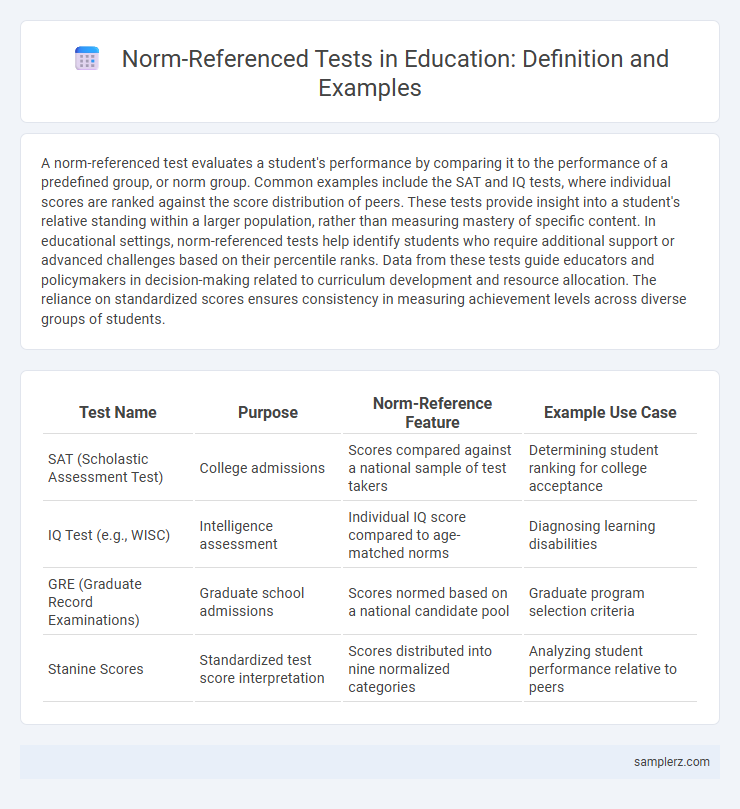A norm-referenced test evaluates a student's performance by comparing it to the performance of a predefined group, or norm group. Common examples include the SAT and IQ tests, where individual scores are ranked against the score distribution of peers. These tests provide insight into a student's relative standing within a larger population, rather than measuring mastery of specific content. In educational settings, norm-referenced tests help identify students who require additional support or advanced challenges based on their percentile ranks. Data from these tests guide educators and policymakers in decision-making related to curriculum development and resource allocation. The reliance on standardized scores ensures consistency in measuring achievement levels across diverse groups of students.
Table of Comparison
| Test Name | Purpose | Norm-Reference Feature | Example Use Case |
|---|---|---|---|
| SAT (Scholastic Assessment Test) | College admissions | Scores compared against a national sample of test takers | Determining student ranking for college acceptance |
| IQ Test (e.g., WISC) | Intelligence assessment | Individual IQ score compared to age-matched norms | Diagnosing learning disabilities |
| GRE (Graduate Record Examinations) | Graduate school admissions | Scores normed based on a national candidate pool | Graduate program selection criteria |
| Stanine Scores | Standardized test score interpretation | Scores distributed into nine normalized categories | Analyzing student performance relative to peers |
Understanding Norm-Referenced Tests in Education
Norm-referenced tests in education assess student performance by comparing individual scores to a predetermined population or norm group, rather than measuring against fixed criteria. For example, the SAT and IQ tests rank students to identify relative achievement levels, highlighting areas of strength and weakness within the norm group. Such tests help educators understand where a student stands in relation to peers, facilitating decisions for placement, advancement, or intervention.
Key Characteristics of Norm-Referenced Assessments
Norm-referenced assessments compare a student's performance to a predefined group, highlighting relative standing rather than mastery of specific content. These tests typically generate percentile ranks, standard scores, and normal distributions to categorize learners. Key characteristics include a fixed scoring interpretation, emphasis on ranking among peers, and the use of representative normative samples for benchmarking.
Classic Examples of Norm-Referenced Tests
Classic examples of norm-referenced tests include the Stanford Achievement Test, the Iowa Test of Basic Skills, and the SAT. These assessments compare a student's performance to a statistically representative group, providing percentile ranks and standard scores. Educators use norm-referenced tests to identify students' relative academic standing and inform placement decisions.
How Standardized Tests Serve as Norm-References
Standardized tests, such as the SAT and ACT, serve as norm-referenced assessments by comparing individual student performance against a representative sample's performance data. These tests generate percentile ranks that indicate how a student's score relates to the norm group, providing educators with a benchmark for evaluating academic achievement. Norm-referenced standardized testing helps identify relative strengths and weaknesses among students, guiding instructional decisions and educational placements.
Interpreting Percentile Scores in Norm-Referenced Testing
Percentile scores in norm-referenced testing indicate a student's relative standing compared to a norm group, with a score at the 75th percentile meaning the student performed better than 75% of peers. These scores help educators identify where a student ranks within a larger population rather than measuring mastery of specific content. Interpreting percentile ranks requires understanding the distribution of scores and recognizing that they reflect relative performance, not absolute achievement.
Comparing Norm-Referenced and Criterion-Referenced Tests
Norm-referenced tests, such as the SAT or IQ assessments, compare a student's performance against a predefined group, ranking individuals to identify relative achievement levels. In contrast, criterion-referenced tests measure a student's knowledge or skills against specific learning objectives or standards, exemplified by state proficiency exams that determine if a student meets grade-level expectations. Understanding these distinctions helps educators choose appropriate assessments tailored to evaluation goals and instructional needs.
The Role of IQ Tests as Norm-Referenced Assessments
IQ tests serve as classic examples of norm-referenced assessments by evaluating individual cognitive abilities relative to a standardized population. These tests compare scores against established norms to determine where a student ranks among peers, facilitating identification of intellectual strengths and weaknesses. Educators use IQ test results to inform instructional strategies and support tailored learning interventions based on relative performance.
SAT and ACT: Leading Norm-Referenced Exams
The SAT and ACT serve as prominent examples of norm-referenced tests, designed to measure students' performance relative to a national sample. These exams rank test-takers, enabling colleges to evaluate applicants based on percentile scores rather than absolute achievement levels. The normative data from millions of test-takers annually ensures standardized comparison across diverse educational backgrounds.
Educational Implications of Using Norm-Referenced Tests
Norm-referenced tests, such as the Stanford Achievement Test, compare a student's performance against a normative sample, providing insight into relative standing among peers. This assessment approach guides educators in identifying students who may require intervention or enrichment by highlighting significant deviations from the normative average. However, reliance on norm-referenced scores can obscure individual learning progress and may not align with specific curriculum goals, affecting instructional planning.
Best Practices for Administering Norm-Referenced Assessments
Administering norm-referenced assessments requires adhering to standardized procedures, including consistent timing, controlled testing environments, and clear instructions to ensure reliability and validity. Utilizing trained examiners and maintaining confidentiality prevents bias and preserves the integrity of the comparative scoring process. Regular calibration of scoring with established norms enhances accuracy in interpreting student performance relative to peer groups.

example of norm-reference in test Infographic
 samplerz.com
samplerz.com